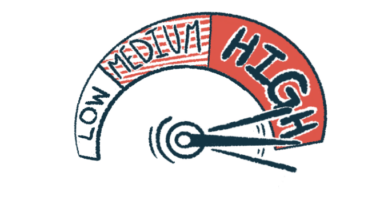AAV may emerge in rare cases after COVID-19 vaccination: Study
More than 75% of people in study achieved remission after treatment

Among the 56 reported cases of new or relapsed ANCA-associated vasculitis (AAV) after vaccination against SARS-CoV-2, more than three-quarters achieved remission with prompt treatment, according to a recent review study. SARS-COV-2 is the virus that causes COVID-19.
AAV after vaccination may be related to several different mechanisms, including inflammation, genetics, and immune impairment, although a cause and effect relationship between AAV and the vaccine hasn’t been established, the researchers said.
“Since AAV is an extremely rare complication after COVID-19 vaccination, the protective influence of COVID-19 vaccination in controlling a global pandemic is undeniable, and timely vaccination should still be recommended,” the researchers wrote in “New insights of antineutrophil cytoplasmic antibody-associated vasculitis from the perspective of COVID-19 vaccination,” which was published in Clinical and Experimental Immunology.
AAV is an autoimmune disease that arises when the immune system wrongly produces self-reactive antibodies, called ANCAs, that damage small blood vessels.
Development or worsening of AAV and other autoimmune diseases have been reported after vaccination against common viruses such as the flu or hepatitis. The mechanisms that might link vaccination to autoimmunity haven’t been established, however.
Phase 3 trials of vaccines against SARS-CoV-2 didn’t report AAV as a side effect. However, as the vaccines were globally adopted during the pandemic, some real-world reports of AAV after vaccination emerged.
New or relapsed AAV after vaccination studied
Researchers in China systematically reviewed studies published up to March that reported on cases of new or relapsed AAV after COVID-19 vaccination.
They identified 56 patients, 44 of whom (78.6%) were newly diagnosed and 12 (21.4%) who had a relapse. The 32 women and 24 men had a median age of 71 (range, 23-85). The vaccine most often received was the mRNA vaccine like that developed by Pfizer-BioNTech or Moderna (76.8%).
AAV symptoms developed a median of 12 days after the first injection for 25 patients (44.6%) and a median of 14 days after the second shot for half of them. Three people (5.4%) had AAV symptoms after a booster dose.
The disease most commonly affected the kidneys (62.5%), followed by the lungs (37.5%). More than half the patients (51.8%) were positive for ANCAs against myeloperoxidase, one of the two most common targets of these self-reactive antibodies.
A significantly greater proportion of new onset patients had at least two other diseases previously compared with those who relapsed (27.3% vs 8.3%).
Most were treated with steroids, while some also received additional AAV therapies such as the immunosuppressive cyclophosphamide and rituximab, or a blood-cleaning procedure called plasma exchange. When there was significant kidney involvement, some patients received dialysis to filter out waste from the bloodstream.
Ultimately, 44 people (78.6%) achieved remission. One person died due to respiratory failure and the remaining patients with available data continued to have AAV complications that required more intervention or ongoing dialysis for kidney disease.
Factors that may lead to AAV after vaccination
The cases underscore that AAV may occur after a COVID-19 vaccination even though “there is no doubt about the efficacy and safety of vaccination,” the researchers wrote, adding the mechanisms by which this might happen still need to be worked out, but they noted a few factors might be involved.
Some healthy people have been found to have ANCAs circulating in their bloodstream that don’t appear to be disease-causing, or pathogenic. It’s possible the immune system being stimulated from a vaccination “may lead to the transformation of ANCA from natural to pathogenic,” the researchers wrote.
Inflammation from vaccines might also trigger the activation of neutrophils, the immune cells that become overactive in AAV due to ANCAs.
Growing evidence also suggests genetic factors — particularly in genes associated with immune responses — may contribute to AAV.
“These genetically susceptible populations may be in a latent state of disease before vaccination,” the researchers wrote, noting immune stimulation from the vaccine could “be the trigger to accelerate the progression of AAV.”
They emphasized these mechanisms are just hypotheses. Large clinical trials and epidemiological studies are needed to establish a potential cause-effect relationship between COVID-19 vaccines and AAV, they said.







